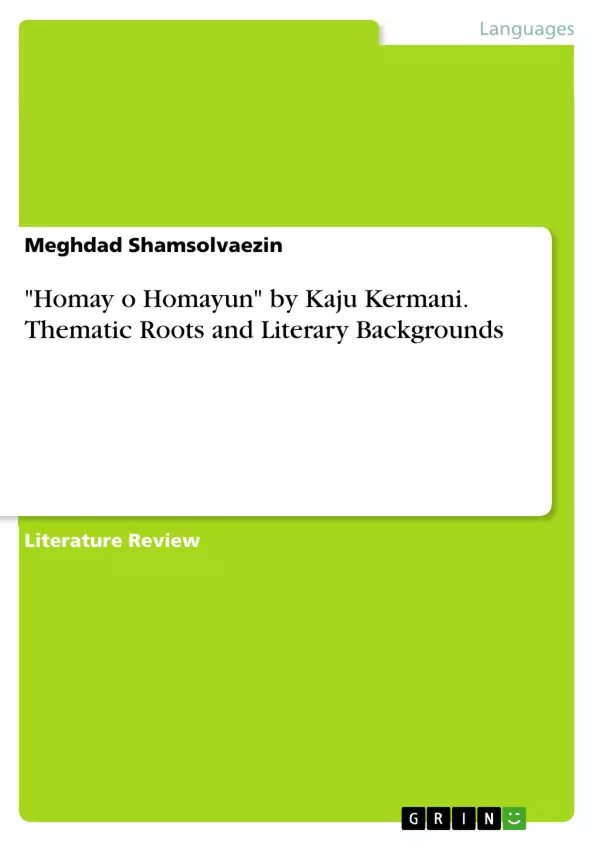This research studies verse romance tale "Homay o Homayun" by Kaju Kermani, a sufi mystic and Persian poet of the early 14th century. This tale is a story of a medieval Syrian prince named Homay who falls in love with a Chinese princess Homayun, just by seeing her portrait on a silk in his dream. He begins a long journey, facing the dragon and reaching the treasure, then he finally becomes the king of all the lands from Syria to China and marries the Chinese princess in a happy ending story. This article tries to expose the importance of Kaju as a fundamental link in mystical poetry study’s chain.
Inhaltsverzeichnis (Table of Contents)
- Introduction
- Subject
- Author
- Homāy o Homāyān text
- Problematic
- Persian Courtly Verse Romance
- Gol o Nowruz
- Vāmīq o Azrā
- Vīs o Rāmīn
- Shāhnāmah
- The Nizāmī Model
- Leylī o Majnun
- Haft Peykar
- Khosrow o Shirin
- Literary Technics
- Protagonist of an Internal Journey
- Homāy and Homāyūn names
- Ethical lessons
- Adversity
- Fights and Achievements
- Auxiliaries
- The Figures of the Guide
- Sorūš
- Onager
- Fairy angels
- Celestial Geography and the Stages of the Journey
- The Garden
- The Desert
- Qāf Mountain
- China
- The Way of Love
- The Perfection of Royalty
- Who is the King?
- Pauper and Prince
- From Ethics to Mysticism
- Transformation
- Metaphors for Union
- Conclusion
Zielsetzung und Themenschwerpunkte (Objectives and Key Themes)
This research delves into the verse romance tale Homāy o Homāyūn, penned by Ķˇāju Kermānī, a Sufi mystic and Persian poet of the early 14th century. The text explores the journey of Homāy, a medieval Syrian prince, who falls in love with a Chinese princess named Homāyūn upon seeing her portrait in a dream. His quest for her, facing challenges and ultimately becoming king, underscores the importance of Ķˇāju's role in the development of mystical poetry.
- Mystical poetry and its development
- The journey of love and self-discovery
- The role of dreams and visions in shaping destiny
- The interplay of ethics and mysticism
- The power of transformation and union
Zusammenfassung der Kapitel (Chapter Summaries)
The story begins in the land of Šām, where King Manūšang-Šāh desires a son. His wish is granted, and he names his son Homāy, after a phoenix that appears on his roof. Homāy grows up strong and intelligent, eventually requesting permission to go hunting. He finds himself lost in the desert and encounters a beautiful garden where he sees a heavenly figure on a golden cloth. This vision, along with a voice that speaks to him, leaves him both enamored and troubled.
Homāy returns to his army, sharing his vision and love for the unknown figure with his companions, who urge him to forget the dream. Despite their concerns, Homāy, driven by his love, decides to pursue his vision and seek the Chinese princess Homāyūn. Homāy, accompanied by his friend Behzād, sets out on a dangerous journey, eventually encountering thieves who capture them.
Through a twist of fate, the ship carrying Homāy and Behzād is thrown upon the shores of Khāvar, where they are welcomed as heroes. An ancient tradition dictates that whoever is found first after the king's death becomes the new ruler. Homāy, though longing to continue his journey, accepts the kingdom as a stepping stone to his ultimate goal.
Homāy rules Khāvar with justice and wisdom, solidifying his reign and preparing himself for the next step in his journey to find Homāyūn.
Schlüsselwörter (Keywords)
Homāy o Homāyūn, Ķˇāju Kermānī, Sufi mysticism, Persian poetry, verse romance, medieval Syrian prince, Chinese princess, love, journey, transformation, celestial geography, ethics, mystical themes, dream visions.
- Quote paper
- Meghdad Shamsolvaezin (Author), 2019, "Homay o Homayun" by Kaju Kermani. Thematic Roots and Literary Backgrounds, Munich, GRIN Verlag, https://www.grin.com/document/470062



